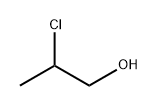Chemical Properties
Propylene chlorohydrin is a colorless liquid.
Chemical Properties
Colorless liquid; mild, nonresidual odor.
Soluble in water and alcohol.
Uses
In preparation of propylene oxide, q.v.
Uses
2-Chloropropanol is used as a solvent in the composition and method for removing a coating from a surface. 2-Chloropropanol is used as an organic solvent in liquid cleaner for the removal of post-etch residues from microsprocessors.
Uses
Propylene β-chlorohydrin is used in the pro duction of propylene oxide.
Synthesis Reference(s)
Journal of the American Chemical Society, 72, p. 4353, 1950
DOI: 10.1021/ja01166a005
General Description
Clear colorless liquid with a pleasant odor.
Air & Water Reactions
Water soluble.
Reactivity Profile
2-Chloro-1-propanol may be sensitive to prolonged exposure to light. 2-Chloro-1-propanol can react with oxidizing agents. .
Hazard
Moderate fire risk. Toxic by ingestion and
skin absorption. Liver damage. Questionable car-
cinogen.
Health Hazard
Propylene β-chlorohydrin is a moderatelytoxic compound having irritant actions onthe skin and eyes. Instilling 2.2 mg of liquidcaused severe eye irritation in rabbits. It cancause poisoning via ingestion, inhalation, andskin absorption. Exposure to 500 ppm for4 hours was lethal to rats. The lethal dosein dogs by oral intake was 200 mg/kg. Thetarget organs are the CNS, gastrointestinalsystem, liver, and kidney.
LD50 value, skin (rabbits): 529 mg/kg
Studies conducted to determine increasedrisks of pancreatic and lymphopoietic can cer among workers in ethylene and propylene chlorohydrin production remained inconclu sive and have given inconsistent findings(Olsen et al. 1997).
Fire Hazard
2-Chloro-1-propanol is flammable.
Safety Profile
Poison by ingestion.
Moderately toxic by inhalation and skin
contact. A skin and severe eye irritant.
Flammable liquid when exposed to heat,
flame, or powerful oxidizers. To fight fire,
use alcohol foam, CO2, dry chemical. When
heated to decomposition it emits toxic
fumes of Cl-.
Potential Exposure
This material is used in organic
synthesis; to make other chemicals.
Shipping
UN2611Propylene chlorohydrin, Hazard class:
6.1; Labels: 6.1-Poisonous materials, 3-Flammable liquid.
Incompatibilities
Vapor may form explosive mixture
with air. Incompatible with oxidizers (chlorates, nitrates,
peroxides, permanganates, perchlorates, chlorine, bromine,
fluorine, etc.); contact may cause fires or explosions. Keep
away from alkaline materials, strong bases, strong acids,
oxoacids, epoxides. Alcohols are sensitive to light and oxi-
dation. It is unstable in solution. It undergoes hydrolysis in
aqueous buffers. Contact with alkali metals, nitrides, and
strong reducing agents may form flammable and/or toxic
gases. May react with anhydrides forming acids and esters,
generating noticeable heat, and also with oxoacids and
carboxylic acids to form esters plus water, but the heat
of reaction in the latter case typically is low. May initiate
the polymerization of isocyanates and epoxides.
Waste Disposal
Dissolve or mix the
material with a combustible solvent and burn in a chemical
incinerator equipped with an afterburner and scrubber.
All federal, state, and local environmental regulations must
be observed.



